Espacios. Vol. 36 (Nº 22) Año 2015. Pág. 7
Implementation of Information and Communication Technologies in the International Trade Negotiation Phases
Implementación de Tecnologías de Información y Comunicación en las Etapas de Negociación Internacional
Jose Jaime BAENA Rojas 1; José Alejandro CANO Arenas 2; Hugo Roman PEREZ Arroyave 3
Recibido: 23/07/15 • Aprobado: 02/09/2015
Contenido
2. Adopting ICT in the international trade negotiation process
5. Conclusions and implications
ABSTRACT: This article describes the real application of information and communication technologies (ICT) into the companies, all of this analyzing some of the most used ICT in the different international trade negotiation phases. Therefore it was carried out a field study in 380 Colombian firms dedicated to import and/or export goods and services. The results shows that the most used ICT for the international trade negotiation phases are the email and the phone, and also it is found that ICT contribute to build rapport, conduct business successfully, support the decision making process and generate negotiation alternatives. |
RESUMEN: Este artículo describe la aplicación de las tecnologías de la información y la comunicación (TIC) en las empresas, analizando las TIC más utilizadas en las diferentes etapas del proceso de negociación internacional. Para esto, se llevó a cabo un estudio en 380 empresas colombianas dedicadas a la importación y/o exportación de bienes y servicios. Los resultados muestran que las TIC más utilizadas en la negociación internacional son el correo electrónico y el teléfono. Igualmente se encuentra que las TIC contribuyen a generar buenas relaciones, hacer negocios exitosos, apoyar el proceso de toma de decisiones y generar alternativas de negociación. |
1. Introduction
In the last years, ICT have allowed firms to capture, process, store and transfer information, and also are acknowledged as a valuable tool for knowledge management process (2014). Therefore ICT contributes to improve the competitiveness of companies, especially Small and Medium Enterprises (SMEs) that represents the majority of companies operating in the world (Consoli, 2012). Hence, the adoption and use of ICT can bring benefits in terms of efficiency, effectiveness, innovation, growth and competitive advantages for international trade negotiations (Cano, Baena, 2015a), providing new solutions to drive value into their business (Harrigan et al., 2008).
In this sense, ICT generate interesting changes in organizational structure, human capital, competitive strategy, and internal organization; besides fosters companies to internationalization processes, even in the case of new born companies (Gerschewski et al., 2015; Diaz-Chao et al., 2015). Enterprises, even SMEs, tend to increasingly use ICT for competitiveness growth, showing that information is the driving force behind economic growth in developing and developed countries (Xiong, Qureshi, 2012). It is also remarkable that all these tools are one of the major globalization drivers and have become into a tool to increase internal efficiency in the firms, including international trade negotiation processes (Gabrielsson, Gabrielsson, 2004).
The adoption of computers, Internet, websites, e-mail and the automation of business functions by enterprises from different sizes, sectors, ages are improving export and import activities (Haugh, Robson, 2005). These technologies can help small businesses to be more competitive with bigger rivals, allowing to SMEs launch complex sales programs and implement effective globalization strategies on Internet just like the bigger companies (Hsiech, Lin, 1998).
Thus some studies can show with mathematical models the influence of the ICT into the enterprises performance and the role of internet networks and infrastructure as a guarantor of development and growth (Botello, Pedraza, 2014). In concordance with these arguments, Gatautis (2008) affirms that governments have been developing new policies, where ICT have been recognized like a strategic issue into the states; requesting review public policies to support ICT implementation, attract foreign investments, encourage the development of own technologies and increase the workforce skills to spread ICT adoption in different regions (Bayo-Moriones, Lera-López, 2007; Williams et al., 2011). Even, many governments in the world have invested in ICT and telecommunications infrastructure to reach a higher internet user penetration, increasing international trade and boosting the gross domestic product level due to electronic commerce revenues (Ho et al., 2001).
Taking into account the contributions and benefits that ICT offer to organizations, this research aims to describe the ICT application in international trade negotiation processes. Thus, in the second section of the article the factors that determine the adoption of ICT, especially in the stages of international negotiations, are studied. In the methodology section the field study in Colombian companies engaged in the import and / or export of goods and services is presented. In the results section, the most used ICT in the different stages of international trade negotiations are analyzed, and the main activities that these technologies provide to companies are discussed. Finally the main conclusions of this study and future lines of work are exposed.
2. Adopting ICT in the international trade negotiation process
The implementation or adoption of ICT to business processes is promoted by different factors such as the impact of the ICT use, easiness access to technologies and the improvement of internal processes (Morgan et al., 2006). Some theoretical models, like the Technology Acceptance Model (TAM) studies the influence of factors on the firm's intentions to start or continue using an ICT (Davis, 1989), ensuring the alignment and compatibility of organizational and productive processes with technologies. Accordingly, the ICT adoption is influenced by the perception of usefulness, the perception of ease of use and security, and by the firm's environment (Yong, 2008; Hernandez-Ortega et al., 2014).
On the other hand, that the adoption for ICT is also determined by demographic factors (age, gender and education level), technological factors (computers and internet access) and cultural factors (face-to-face vs ICT mediated negotiations paradigm), suggesting that SMEs and other enterprises will adopt ICT just when these factors have been considered (Cano, Baena, 2013; Kusumaningtyasa, Suwarto, 2015). However, some companies believe that negotiations mediated with ICT are depersonalized, representing threats related to users' privacy breaches, credibility and trust, causing discomfort and distress during transactions or deals (Najafi, 2012).
According to previous ideas, Figure 1 exposes some factors that users and enterprises must consider to adopt ICT successfully.
Figure 1. Main factors that influence for not ICT implementation.
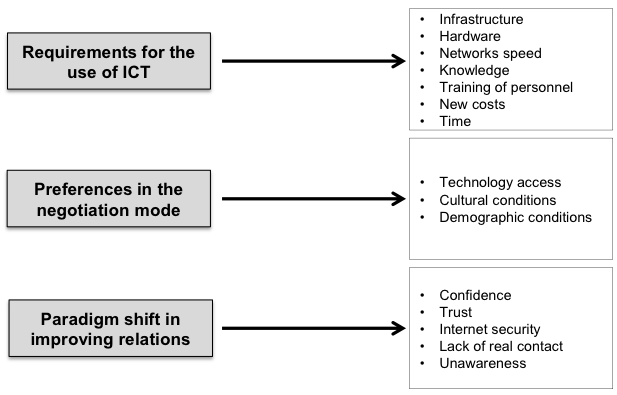
Source: Authors
The factors mentioned above must be applied at every phase of the international trade negotiation process, which are categorized in different ways, covering from beginning to end the needed activities to achieve an agreement or deal. According to Lim and Murnighan (1994), the negotiation process is formed by phases as proposal, message, concession and agreement. Kersten and Lai (2010), exposed that negotiation process is really formed by phases such as planning, exploration, exchange, agreement, conclusion and evaluation. Nevertheless, as Figure 2 shows, (Cano, Baena, 2015b) proposes to study this process in three phases: preparation, dialogue and closure.
Figure 2 Processes in the international business stages and potential ICT.
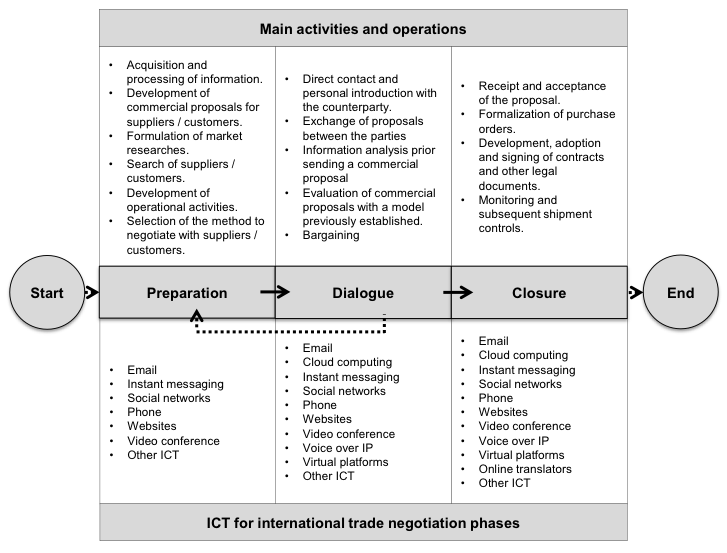
Source: Authors
Furthermore, as shown in Figure 2, there are many synchronous and synchronous ICT that can be implemented in each phase to improve the international trade negotiation process; besides that all this kind of ICT are designed to perform different tasks and requirements, collect, process and organize different information, search for other organizations, design alternatives, create reports, among others. These ICT have special features that can be exploited by users or organizations, making more effective and easier the communication and information management (Pauleen, Yoong, 2001; Cano, Baena, 2015).
Kersten et al., (2013) affirm that international trade negotiation is conditioned by the flexibility of the parts to make concessions in negotiations and auctions, and it has a critical impact on the outcomes of an exchange. This approach can be combined with ICT, and even this has been observed with theoretical experiments associated with the zero-sum game, in scenarios which the gain or loss of a participant balances with the losses or gains of the other counterparty. So it is relevant to mention that Kersten and Lai (2007) show that the structure of the negotiation process depends on the negotiators' characteristics, the problem and the context in which an agreement is sought; and ICT allows the construction of protocol formalisms where users can select an alternative that suits them and/or is appropriate to the problem they affront. Furthermore, these protocols that can be modified during the user–system interactions.
Hence, it can be said that the negotiation process has changed due to the adoption and use of ICT, situation that raised a multitude of alternatives and new steps to negotiate (Kersten, Lo, 2001). Electronic negotiations have been identified as a coordination mechanism for the interaction of buyers and sellers in electronic markets, where all kind of products and services are traded (Bichler et al., 2003); therefore, electronic negotiations have been classified as a new and interdisciplinary research field, which is attractive due to the increment of the electronic commerce and electronic markets where ICT are implemented.
Given that there are different ICT for international trade negotiations, it is necessary to make a study field to consider which technologies are most commonly used in each phase, and what activities are facilitated due to its use.
3. Methodology
To carry out the field study it was necessary to identify the Colombian enterprises registered in the official customs Dirección de Impuestos y Aduanas Nacionales (DIAN), dedicated to export or import goods/services. With this information, a stratified proportional random sampling for a finite population was applied (Equation 1).
 Equation (1)
Equation (1)
The data used in Equation 1 and the sample size results are presented in detail in Table 1.
Table 1. Definition and value of parameters for sample size calculation
Parameter |
Definition |
Value |
N |
Population size |
41.546 |
E |
Estimation error, maximum acceptable error in study |
5% |
P×(1-P) |
Variance of sample |
25% |
Z |
Probabilistic factor given by a 95% confidence level |
1,64 |
n |
Sample size |
380 |
Source: Authors
The results obtained in Table 1 led to a sample size of 380 companies, which are distributed among the main regions in Colombia. Table 2 shows the number of companies in each region of the field study.
Table 2. Distribution of the sample among Colombian regions
Position |
Region |
Sector |
Subtotal |
% Total |
||
Primary |
Secondary |
Tertiary |
||||
1 |
Cundinamarca |
53 |
92 |
86 |
231 |
61% |
2 |
Antioquia |
8 |
30 |
15 |
53 |
14% |
3 |
Valle del Cauca |
17 |
21 |
10 |
48 |
13% |
4 |
Santander |
5 |
10 |
4 |
19 |
5% |
5 |
The other |
4 |
18 |
7 |
29 |
8% |
Total |
87 |
171 |
122 |
380 |
100% |
|
23% |
45% |
32% |
||||
Source: Authors
A telephone survey was applied to the selected companies, and this research instrument contained several questions that allowed identify the main ICT implemented in into the different trade negotiation phases and describe the main functionalities that ICT brings to the international negotiation process.
4. Results and discussion
Once the research was applied, it was possible identify if ICT are really commonly used to support the international trade negotiation process. When an enterprise plans its negotiation itinerary with the counterparty, this process commonly begins with the preparation phase. For this phase, all the companies of the field study agreed that the most used ICT are the email, the phone, the counterparty website, online yellow pages, instant messaging among others.
Considering Graphic 1, there is a significant implementation of the email, with a 98% of use in Colombian companies; regarding the rest of the companies, 1% of them use sometimes email for the first phase of the negotiation process, and other 1% do not use this technology in the preparation phase.
Graphic 1. ICT used in the preparation phase
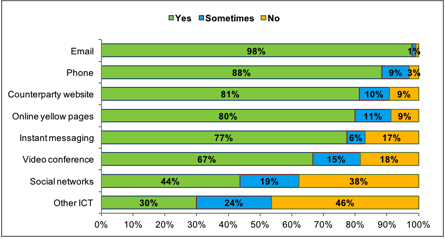
Source: Authors
The phone is a traditional technology that is not based in internet, like the others technologies analyzed in this study, and is used by 88% of the companies. It is used to interchange points of view with audio in real time, and it is very important to acquire information before bargaining. Around 9% of companies use sometimes the phone and 3% definitely do not use the phone in the preparation phase.
The companies also use the counterparty website, about 80% use frequently this technology in the preparation phase, because it allows to meet any enterprise with all its information, including the products features, quality and price, corporative elements of the counterparty, among others. Online yellow pages, instant messaging and video conference are also highly used in the first phase of the international trade negotiation process, and are constantly used by 80%, 77% and 67% of companies respectively. However, social networks (Tweeter, Facebook, Youtube, Linkedin, etc.) and other ICT are actively used by 44% and 30% of the companies respectively to acquire and process information in the preparation phase.
Similarly, Graphic 2 consider de use of ICT for the dialogue phase, where the most used ICT still been the email and phone, which are adopted by 96% and 88% of the companies respectively; it could be explained because these technologies guarantee agile communication and interchange of information between the parts, at a low cost. The instant messaging (Facebook Chat, Skype Chat, MSN Messenger, BlackBerry Messenger, NetMeeting, Google Talk, Whatsapp or other similar software) and the video conference (Skype, Windows Messenger, Google Talk, Tango, Netmeeting and others) are used by more than 60% of companies to communicate, interchange information, carry out concessions and to find mutual benefits.
Graphic 2. ICT used in the dialogue phase
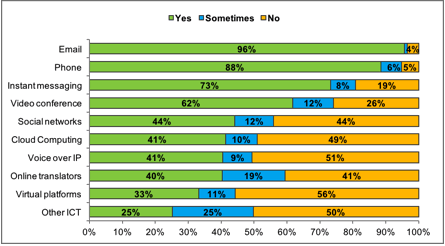
Source: Authors
Considering the remaining technologies that can be used in the dialogue phase, such as social networks, cloud computing (Dropbox, SkyDrive, Google Drive, among others), voice over IP, online translators and virtual platforms (E-Procurement, E-Sourcing, E-Bidding), are used constantly by 44%, 41%, 41%, 40% and 33% of the companies respectively. So, these technologies are used as a support and complement of other ICT to get in touch and share information with the counterparty, and analyze the information obtained from them. About a quarter of the companies use other ICT to perform the dialogue phase.
For the third phase of the negotiation process, Graphic 3 shows that email and phone are the most important and strategic ICT to support the closure of an international trade negotiation. Email is used by 92% of the companies, and the phone by 83% of them.
Graphic 3. ICT used in the closure phase
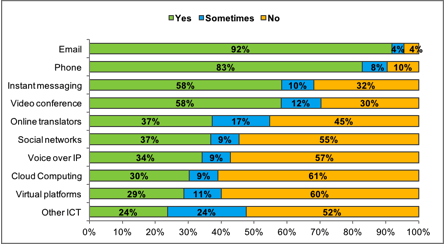
Source: Authors
Instant messaging and video conference reach the 58% of the firms that use these ICT to achieve an agreement to import or export goods/services. Other technologies like social networks, voice over IP, cloud computing, virtual platforms and online translator are used by a range from 29% to 37% of the firms in Colombia to validate all the terms of an international contract. It is relevant to indicate that 24% of the companies use other ICT, which can be specialized or are not conventional used in this phase of a negotiation
Then, to compare the use of ICT among the phases of the negotiation process, Graphic 4 confirms that the most used ICT in the whole process are the email and phone, and it is explained in part because these technologies are available for companies, are used not only for negotiation processes, but also for other business activities, and offer synchronous (phone) and asynchronous (email) communications. The email and phone are followed by instant messaging, video conference, social networks and other ICT regarding to level of use in companies for the preparation, dialogue and closure phases.
Graphic 4. ICT used in preparation, dialogue and closure phases
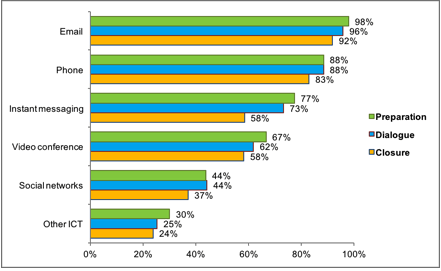
Source: Authors
Also, it can be deduced from Graphic 4 that the phase with more utilization of ICT is the preparation phase, followed by dialogue phase and closure phase. It could happen due to the information needed to prepare a negotiation, which involves know for first time other companies, ask for basic information to the counterparty before bargaining, etc. Another explanation to these results is that as a negotiation tends to an agreement, the parts want to feel more confident and build rapport through personal contact. It should be clarified that some ICT mentioned in this section of the article were not considered in this analysis because they do not apply for every phase of the negotiation process.
So considering other results of this research, Graphic 5 presents how companies assess some activities that ICT are able to facilitate in international trade negotiations.
Graphic 5. Activities facilitated by ICT in international trade negotiations
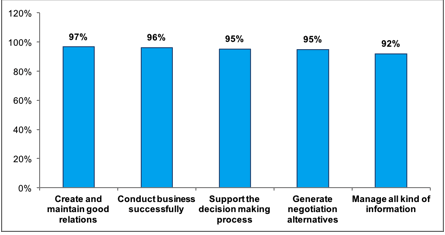
Source: Authors
It is observed that a significant amount of Colombian companies (more than 90% of them) recognize that ICT helps to create and maintain good relations with the counterparty. Technologies such as email, phone, instant messaging, video conference, social networks, voice over IP, cloud computing, virtual platforms, and all other mentioned previously, facilitate conducting business successfully, support decision-making processes, generate more alternatives for negotiation, and improve information management.
These results confirm that ICT bring benefits to the international trade negotiation process regarding to handling information in audio, video and text formats, allowing the management of verbal and no verbal data, and also generating an appropriate support to buyers and sellers to achieve efficiency and efficacy in their operations.
5. Conclusions and implications
In Colombia the most used ICT in all the phases of the international trade negotiation process are the email and the phone, due to the versatility that they offer with synchronous (phone) and asynchronous (email) communications. Another reason that encourages the use of email and phone is that these ICT are already available in companies, used in other business processes. Similarly, instant messaging and the video conference are very used by companies in preparation, dialogue and closure phases, enabling different levels of formality in synchronic communication, according to the needs of each company. It should be noted that the above ICT are easy to use, theirs acquisition and operation costs are low or free, their operability is based on internet, and are widely used by people in other scenarios which facilitates their acceptance and use.
Other ICT as social networks, counterparty website, online yellow pages, virtual platforms, voice over IP, cloud computing and online translators are considered by Colombian companies as a complement of email and phone, providing alternatives to acquire, store and process information in audio, video and text formats in some of the phases in international trade negotiations.
Likewise, the research identifies that ICT are very important to carry out an international trade negotiation, highlighting that these technologies facilitate to companies activities related with build rapport, conduct business successfully, generate negotiation alternatives, support the decision making process, and facilitate managing information. All this motivates companies to continue using these technologies to get better results in terms of efficacy and efficiency, and promote international trade dynamics.
For future lines of research, it is recommended to reproduce this study in other countries, and similarly replicate the methodology presented in this article, with the main purpose to recognize which are the most used ICT into international trade negotiation; and to identify the activities that all these tools can facilitate when enterprises buy or sell products in international markets.
6. References
ÁLVAREZ-MEAZA, I.; Cilleruelo-Carrasco, E.; Zamanillo-Elguezabal, I. (2014); "Web 2.0 as a key tool for sharing knowledge in Basque Country SMEs", Dirección y Organización, 53(1), 58-64.
BAYO-MORIONES, A.; Lera-López. F. (2007); "A firm-level analysis of determinants of ICT adoption in Spain", Technovation, 27(6-7), 352–366.
BICHLER, M; Kersten, G; Strecker, S. (2003); "Towards a Structured Design of Electronic Negotiations", Group Decision and Negotiation, 12(4), 311-335.
BOTELLO, H; Pedraza, A. (2014); "Las tecnologías de la información y la comunicación y el desempeño de las firmas: evidencia de las firmas industriales del Ecuador", Revista Ciencias Estratégicas, 22(31), 19-32.
CANO, J; Baena, J. (2013); "Retos en la implementación de las TIC para el proceso de negociación internacional", Cuadernos De Administración, 29(50), 153-63.
CANO, J; Baena, J. (2015); "Impact of Information and Communication Technologies in International Negotiation Performance", RBGN-Revista Brasileira de Gestao de Negocios, 17(54), 1-17.
CANO, J; Baena, J. (2015); "Tendencias en el uso de las tecnologías de información y comunicación para la negociación internacional", Estudios Gerenciales, 31(136), 1-12.
CONSOLI, D. (2012); Literature Analysis on Determinant Factors and the Impact of ICT in SMEs. World Conference on Business, Economics and Management, Antalya - Turkey.
DAVIS, F. (1989); "Perceived Usefulness, Perceived Ease of Use, and User Acceptance of Information Technology", MIS Quarterly, 13(3), 319-339 .
DIAZ-CHAO, A; Sainz-González, J; Torrent-Sellens, J. (2015); "ICT, innovation, and firm productivity: New evidence from small local firms", Journal of Business Research, 68(7), 1439–1444.
GABRIELSSON, P; Gabrielsson, M. (2004); "Globalizing internationals: business portfolio and marketing strategies in the ICT field", International Business Review, 13(6), 661–684.
GATAUTIS, R. (2008); "The impact of ICT on public and private sectors in Lithuania", Engineering Economics, 4(59), 18-28.
GERSCHEWSKI, S; Rose, E; Lindsay, V. (2015); "Understanding the drivers of international performance for born global firms: An integrated perspective", Journal of World Business, 50(3), 558–575.
HARRIGAN, P; Boyd, M; Ramsey, E; Ibbotson, P; Bright, M. (2008); "The development of e-procurement within the ICT manufacturing industry in Ireland", Management Decision, 46(3), 481-500.
HAUGH, H. M; Robson, P. (2005); "Are Scottish firms meeting the ICT challenge? Results from a National survey of enterprise", Entrepreneurship and Regional Development, 17(3), 205-222.
HERNANDEZ-ORTEGA, B; Serrano-Cinca, C; Gomez-Meneses, F. (2014); "The firm's continuance intentions to use inter-organizational ICTs: The influence of contingency factors and perceptions", Information Management, 51(6), 747–761.
HO, S; Kauffman, R; Linag, T. (2001); "Internet-based selling technology and e-commerce growth: A hybrid growth theory approach with cross-model inference", Information Technology and Management, 12(4), 409-429.
HSIECH, C; Lin, B. (1998); "Internet commerce for small businesses", Industrial Management and Data Systems, 99(3), 113-119.
KERSTEN, G; Lai, H. (2007); "Satisfiability and completeness of protocols for electronic negotiations", European Journal of Operational Research, 922–937.
KERSTEN, G; Lai, H. (2010); "Electronic negotiations: Foundations, systems, and processes", Advances in Group Decision and Negotiation, 4(1), 361–392.
KERSTEN, G; Lo, G. (2001); "Negotiation support systems and software agents", E-business negotiations, 1(1), 1-9.
KERSTEN, G; Vahidov, R; Gimon, D. (2013); "Concession-making in multi-attribute auctions and multi-bilateral negotiations: Theory and experiments", Electronic Commerce Research and Applications, 12(3), 166–180.
KUSUMANINGTYASA, N; Suwarto, D. (2015); ICT Adoption, Skill and Use Differences among Small and Medium Enterprises Managers Based on Demographic Factors. The 6th Indonesia International Conference on Innovation, Entrepreneurship, and Small Business, Bali - Indonesia.
LIM, S; Murnighan, J. (1994); "Phases, deadlines, and the bargaining process", Organizational Behavior and Human Decision Processes, 58(2), 153–171.
MORGAN, A; Colebourne, D; Thomas, B. (2006); "The development of ICT advisors for SME businesses: An innovative approach", Technovation, 26(8), 980–987.
NAJAFI, I. (2012); "The role of e-commerce awareness on increasing electronic trust", Life Science Journal, 9(4), 1487-1494.
PAULEEN, D; Yoong, P. (2001); "Relationship building and the use of ICT in boundary-crossing virtual teams: A facilitator's perspective", Journal of Information Technology, 16(4), 205-220.
WILLIAMS, R; Graham, I; Jakobs, K; Lyytinen, K. (2011); "China and Global ICT standardisation and innovation", Technology Analysis and Strategic Management, 23(7), 715-724.
XIONG, J; Qureshi, S. (2012); Analysis of information and communications technology adoption between small businesses in China and the United States. 18th Americas Conference on Information Systems 2012, Seattle - United States.
YONG, L. (2008); "Modelo de aceptación tecnológica (TAM): Un estudio de la influencia de la cultura nacional y del perfil de los usuarios en el uso de las TIC", Revista Internacional de Ciencias Sociales y Humanidades, 14(1), 131-171.1. Faculty of Economic and Administrative Sciences, Universidad de Medellin, Colombia. Career in Political Science and International Business, Master in Internationalization, PhD(c) in Law and political science. jjbaena@udem.edu.co
2. Faculty of Economic and Administrative Sciences, Universidad de Medellín, Colombia.Industrial Engineer, Magister en Ingeniería Administrativa. jacano@udem.edu.co
3. Faculty of Economic and Administrative Sciences, Luis Amigo University Foundation, Colombia. Economist, Master of Business Administration in International Business. hugo.perezar@amigo.edu.co